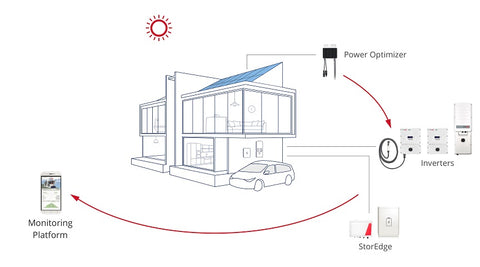Setting up a solar system the complete guide

In light of the new regulation by the Israeli Electricity Authority from September 2018, the considerations and specifications for building a solar system have undergone a fundamental change. Here, we will examine under what conditions installing a solar electricity generation system under the new regulation by the Israel Electric Corporation is worthwhile, and what are the main factors to consider to ensure maximum efficiency and profitability of the solar energy system.
The Net Metering System Regulation
As of December 2017, the Net Metering regulation was in place but was modified and updated by the Electric Corporation, taking effect in September 2018. The main focus of this new regulation is to encourage private homeowners, small businesses, and public bodies to transition to independent electricity production for self-consumption, with government assistance and various incentives.
Net Metering - As of September 2018, no further registrations for this regulation are allowed. The purpose of this regulation is to encourage the production of solar energy for self-consumption. Therefore, the main emphasis is on electricity savings. The primary rule states that any energy unit (kWh) generated and consumed on-site by the customer will not be charged by the electric company.
If the system's production exceeds local consumption, the excess energy is fed into the electric grid. In this case, the regulation benefits consumers by crediting them financially based on the same consumption tariff.
Since the customer effectively uses the electric grid as a type of energy storage facility, the electric company charges a "grid usage fee" (currently set at 3 agorot per kWh).
All financial calculations are based on the "Time of Use" (TOU) tariff, and thus the customer must be connected under this tariff.
This credit can accumulate and roll over for up to two years but must be settled afterward (either sold to a third party at production cost or written off).
Key Points of the New Solar Roofs Revolution (September 2018)
In line with the Israeli government's policy to transition to green energy and clean electricity, the regulation was changed, and a trend began to encourage private homeowners, public bodies like schools, factories, and small businesses to install solar systems, with assistance in funding and affordable loans.
Highlights of the New Solar System Regulation (September 2018):
- A. Tariff Regulation for Small Installations: Up to 15 kW at a rate of 48 agorot per kWh.
- B. Tariff Regulation for Medium Installations: 15 to 100 kW at a rate of 45 agorot per kWh.
- C. Updating Net Metering Regulation: Expanded by 100 MW.
- D. Regulation for Self-Consumption of Roof-Generated Electricity.
Additionally, to encourage investment in solar systems, income tax exemption is granted for electricity production up to 24,000 NIS annually under the new regulation. There is also a VAT exemption for electricity production up to 70,000 NIS annually. Regarding the exemption from building permits, the threshold has been increased from 50 kW to 700 kW.
First Steps in Solar Energy Systems
When considering installing a solar system, there are a few preliminary steps to determine if a solar installation is suitable.
First, check whether the property or land is legally owned by the person intending to establish the solar system, and whether all building additions were made with proper permits.
Next, examine the available space. If there is sufficient land or roof space, consider whether the roof is oriented to the south and has a suitable slope (26 degrees is ideal).

Home Solar System
A home solar energy system is up to 15 kW. The electric company allows a deviation of up to 10% between the nominal system power connected to the grid (AC) and the installed panel capacity (DC). Therefore, the largest home system allowed today is 16.5 kW. For systems up to 4 kW, there is no need to declare income to the tax authority, but for larger systems or incomes exceeding 18,000 NIS annually, tax filings are required.
There are two types of home systems: flat roof systems and tiled roof systems. Flat roof systems take up more space and are slightly more expensive because of the spacing required between rows of panels to minimize shading effects.
Required Approvals for Solar Installation
To install a solar system on a roof or land, certain approvals are needed, including proof of ownership, approval from an electrical engineer, and in the case of flat roofs or land, a structural engineer’s approval. The entire approval process typically takes about two months for home systems.
Maintenance of Solar Systems
Solar systems require mainly cleaning to maintain high electricity production. Cleaning should be done according to the manufacturer's instructions. For roofs with difficult access, special poles can be used to clean the panels.
Regular maintenance is simple, but more advanced systems that track the sun's movement may require additional mechanical upkeep, such as lubricating and replacing parts.

Components of a Solar Energy System
- Photovoltaic Collectors: These are the solar panels, chosen based on the engineer's recommendation.
- Solar Inverter: Converts the electricity generated from the collectors into grid-compatible electricity.
- Solar Monitoring System: Monitors the system's performance, allowing optimization of electricity production.
- Two-Way Meter: Measures electricity consumption and production for billing by the electric company.
- Wiring and Connectors: Connect the panels to the inverter and the electrical panel.

SolarEdge Energy Systems provide maximum output, including panels, optimizers, and inverters with real-time monitoring capabilities. These systems can generate up to 25% more electricity than other solar systems.

Advice offers the latest and most advanced solar inverters with optimizers, monitoring, and control by SolarEdge, with extended warranties up to 20 years. Contact us for guidance and more information about setting up your solar system.
{formbuilder:5446}


